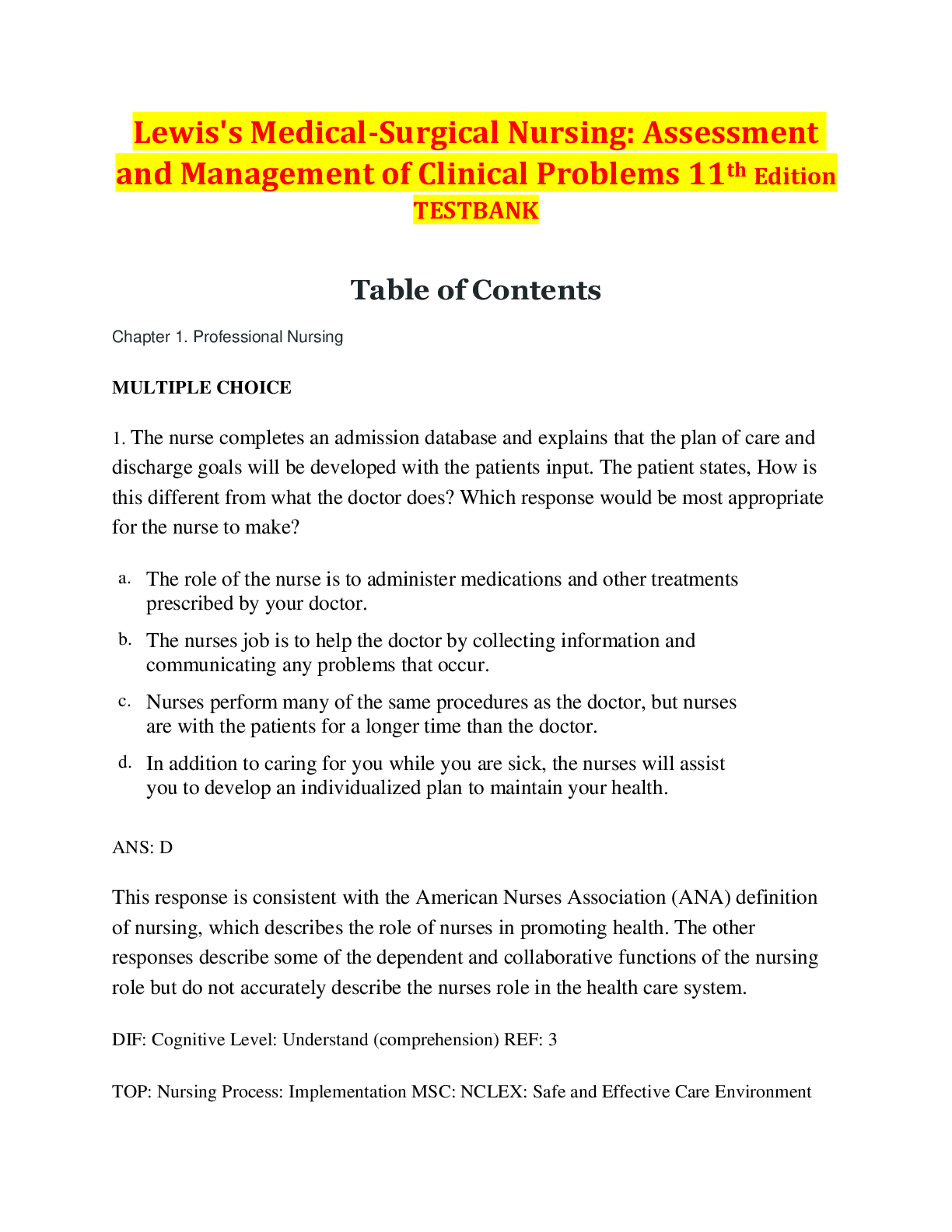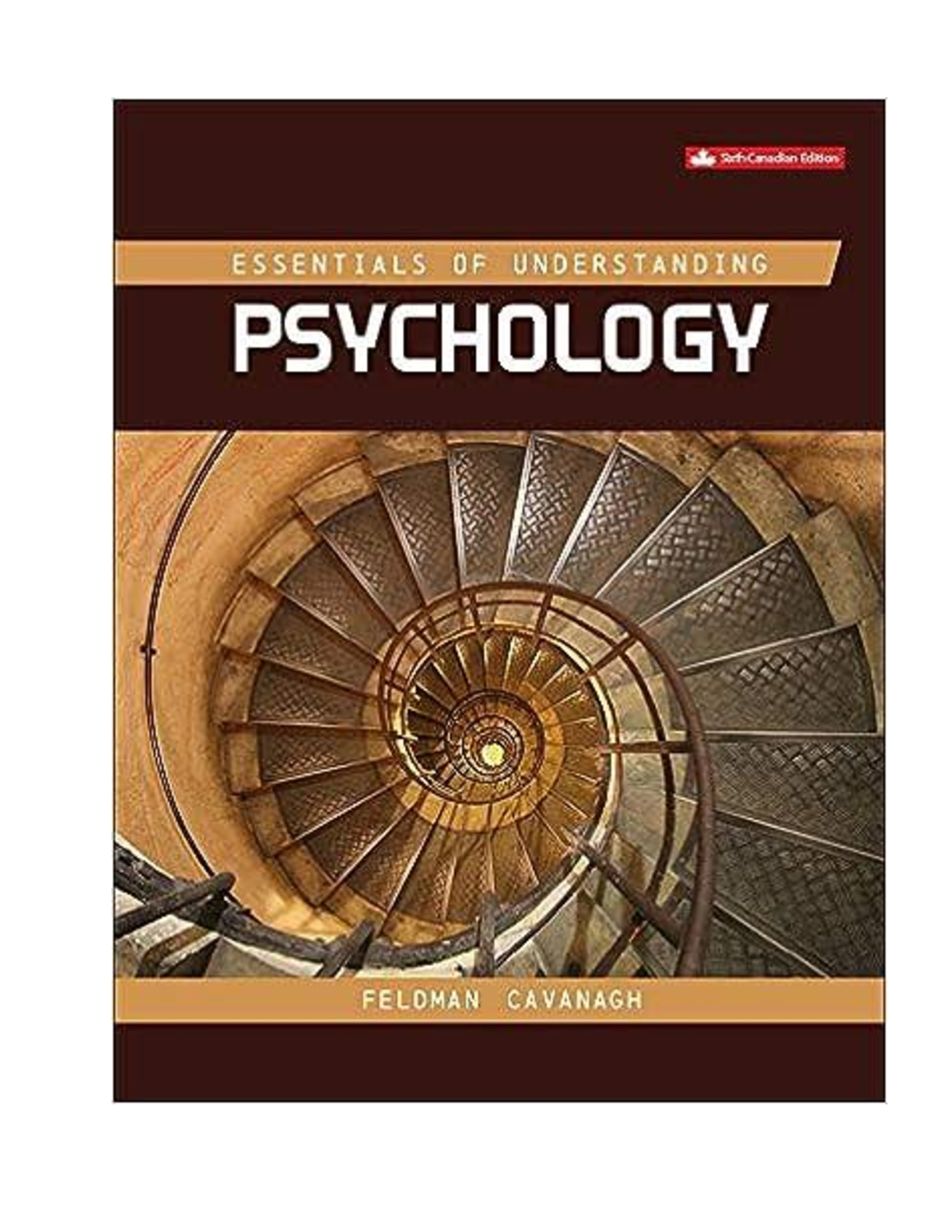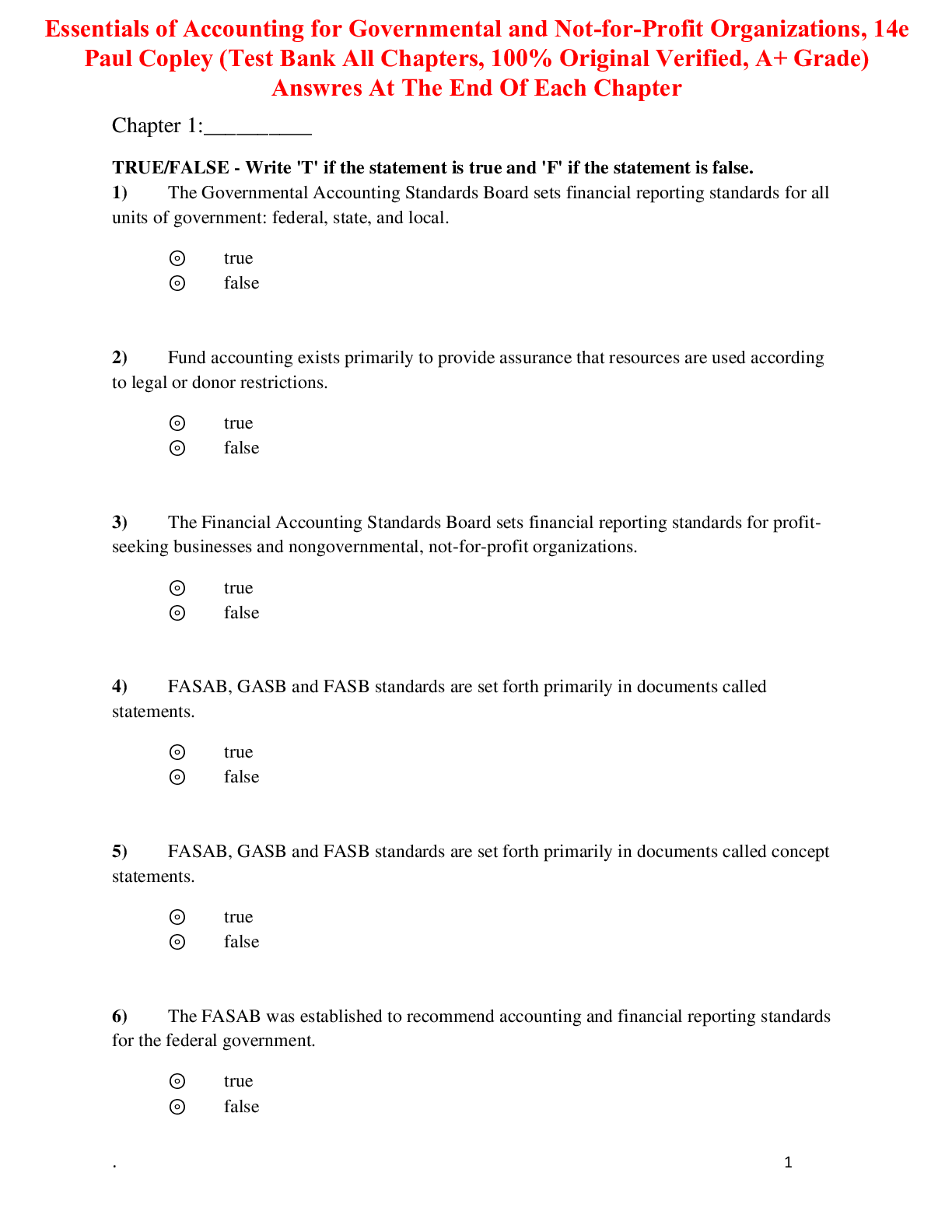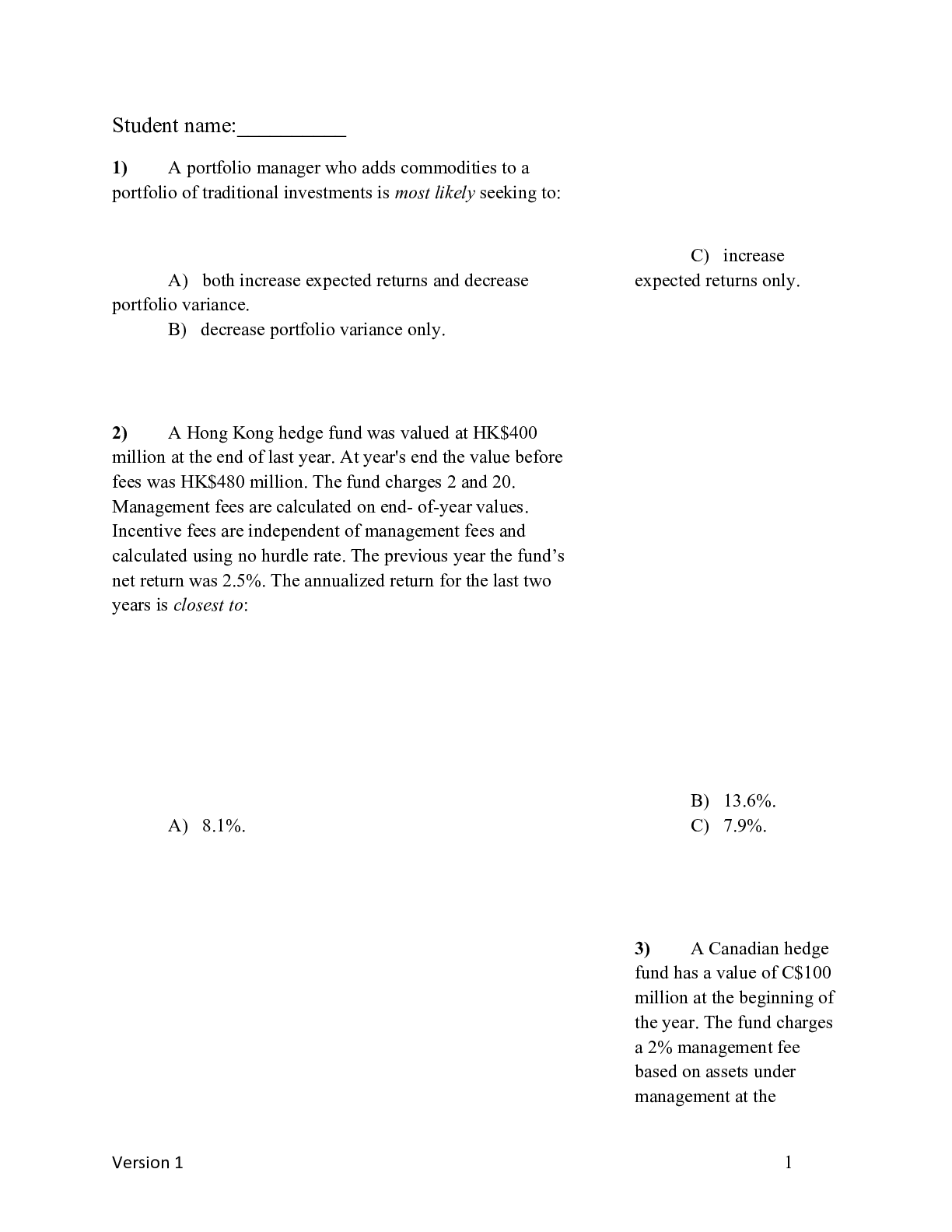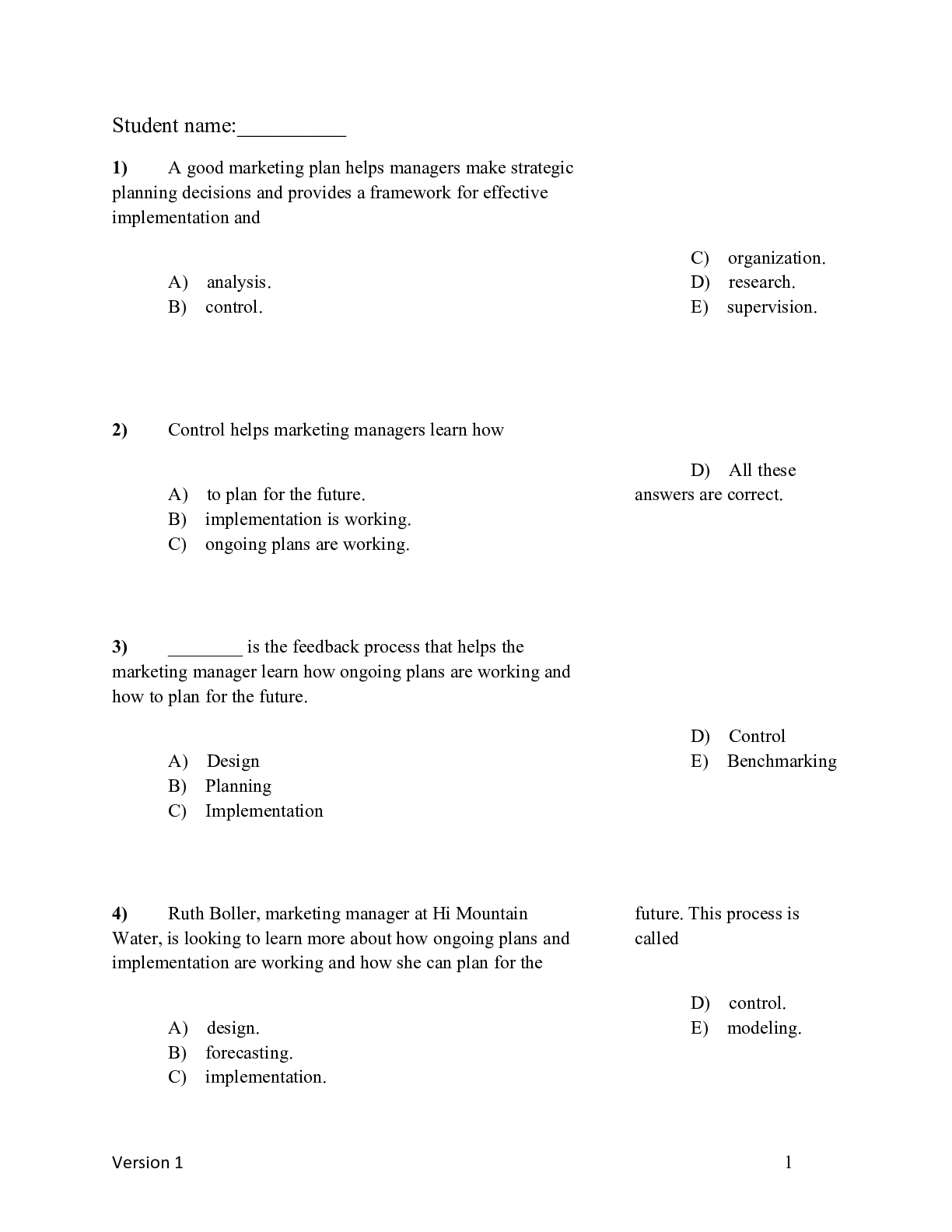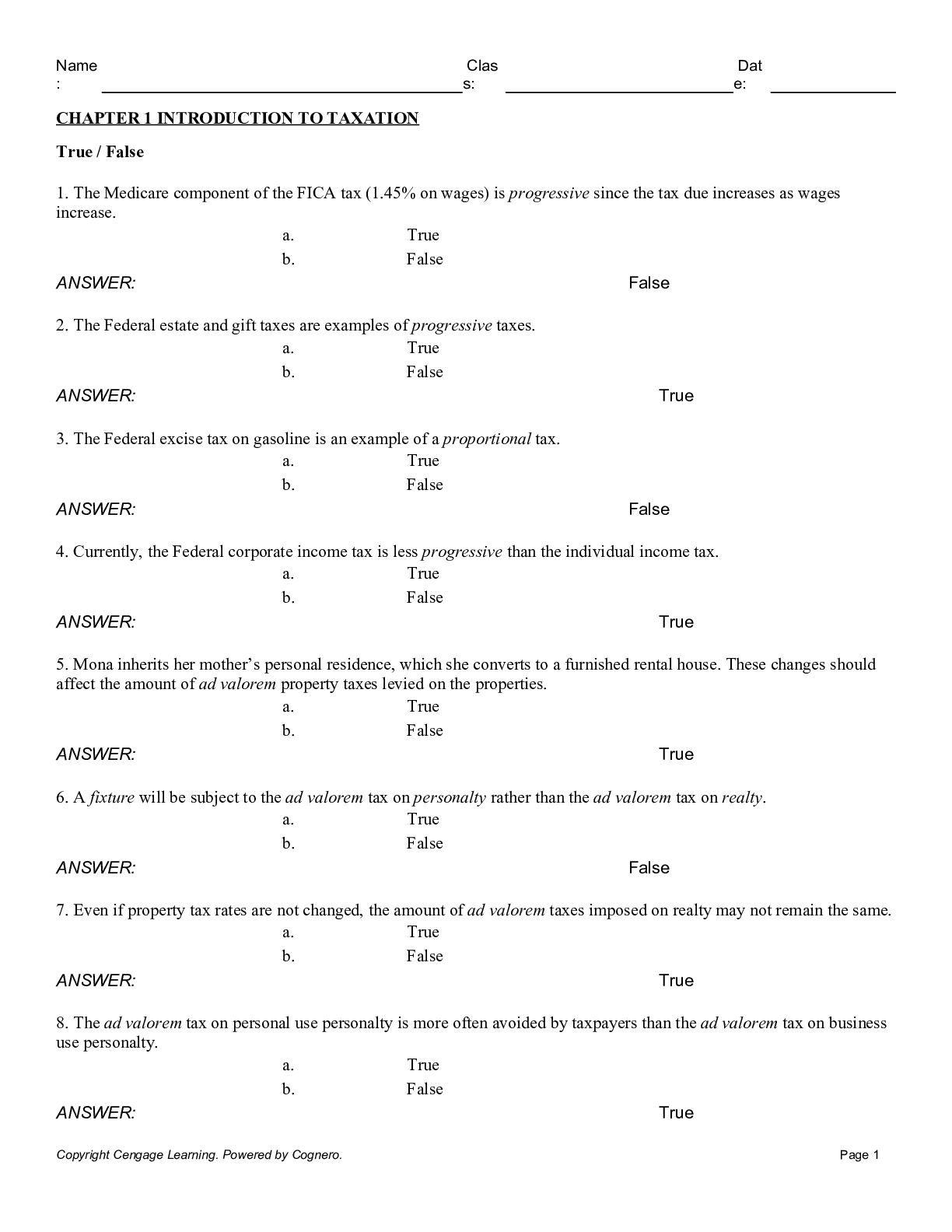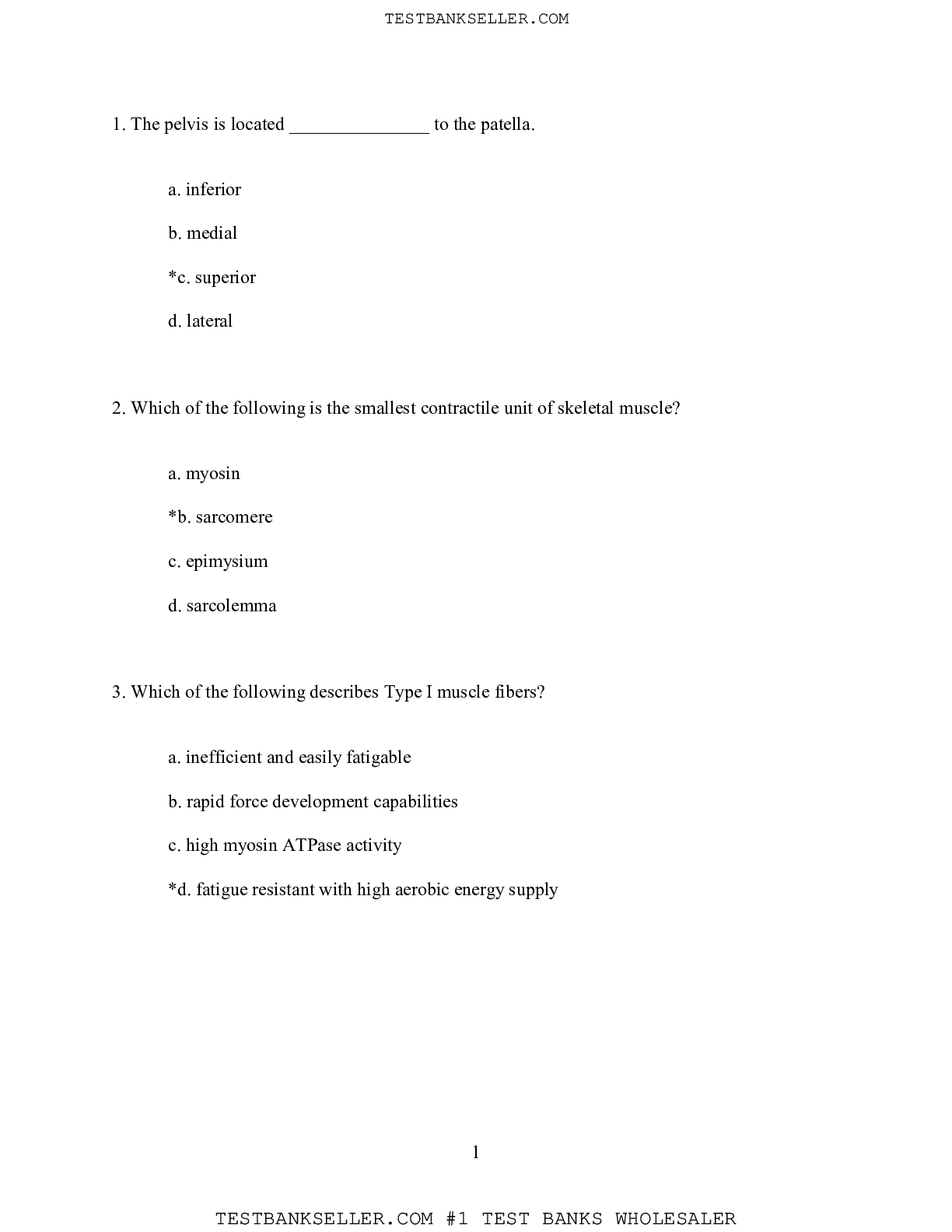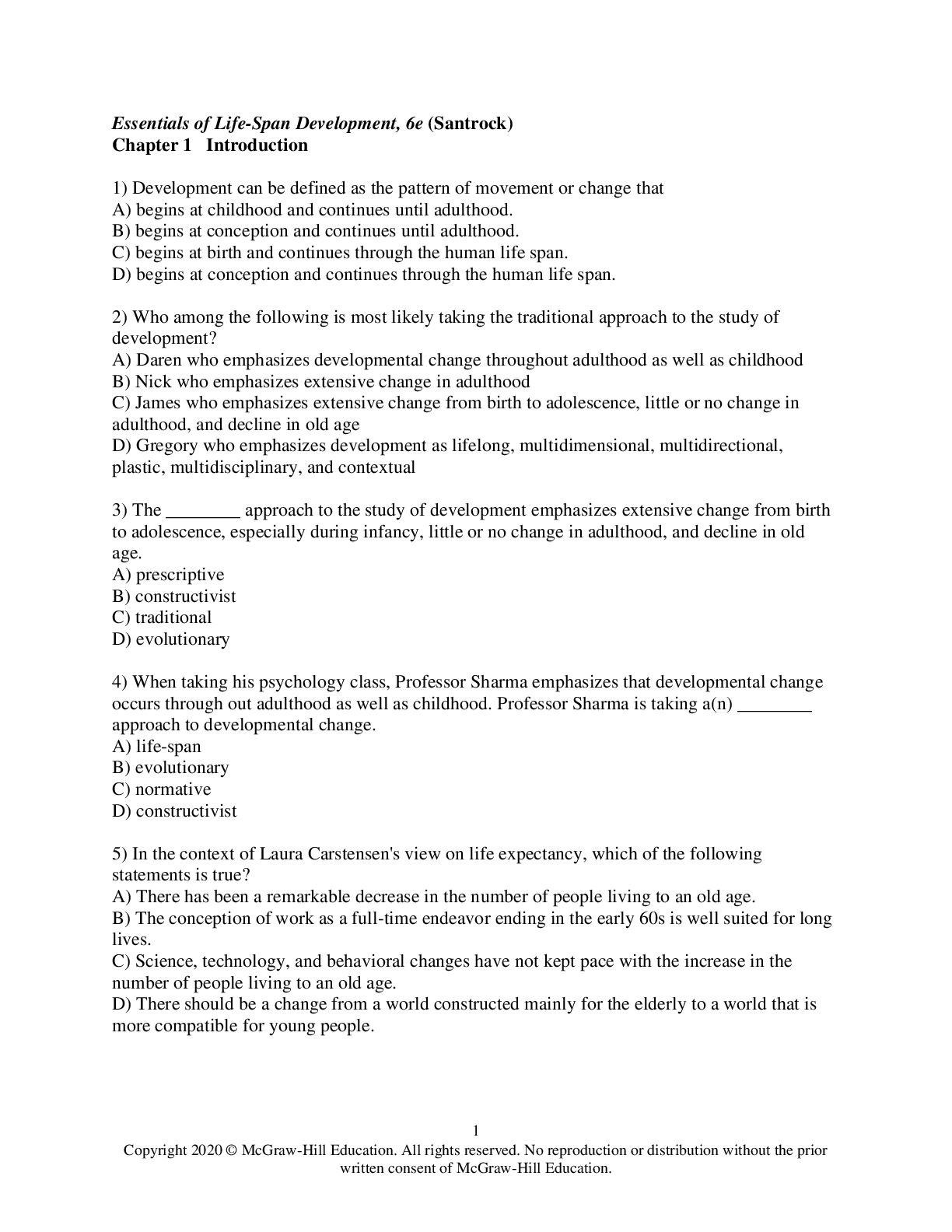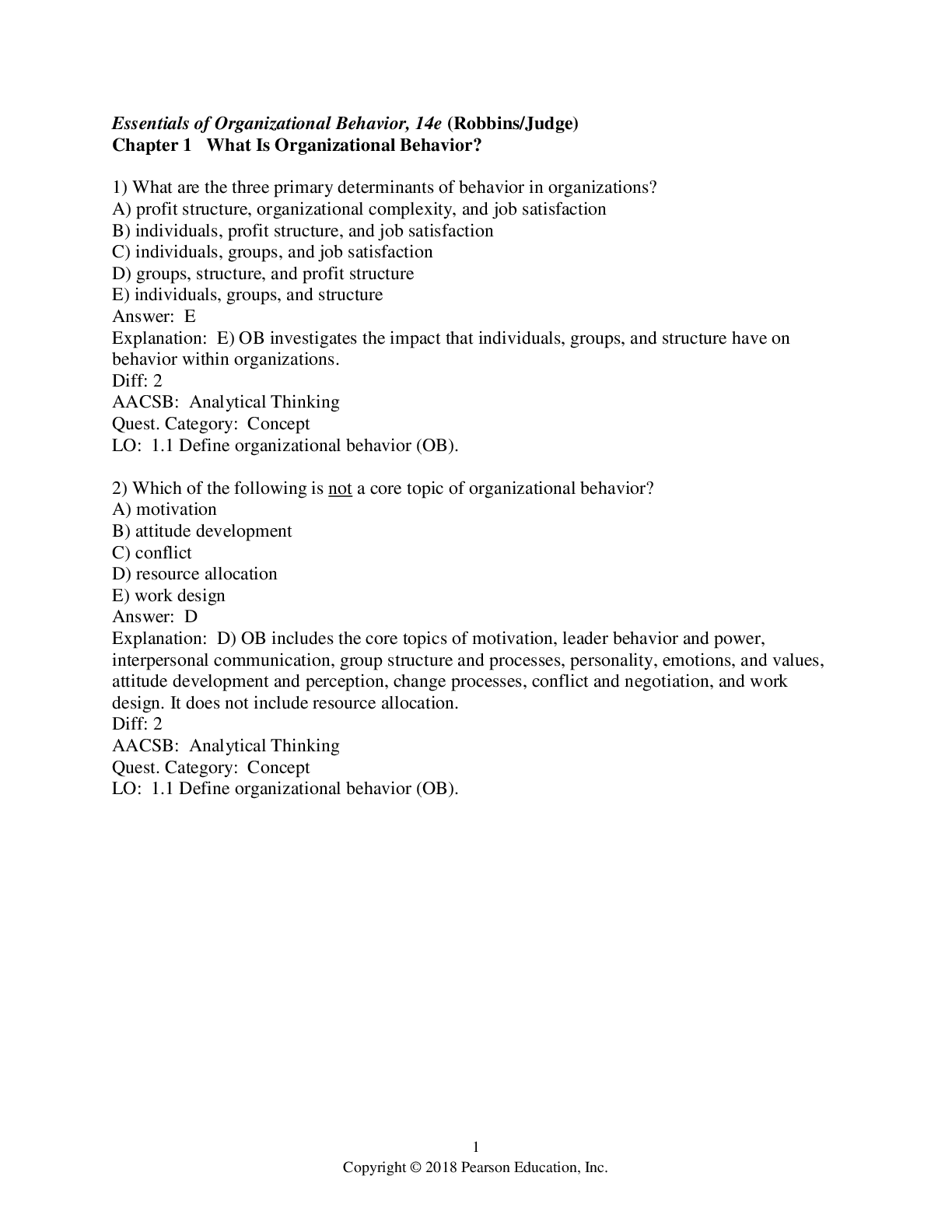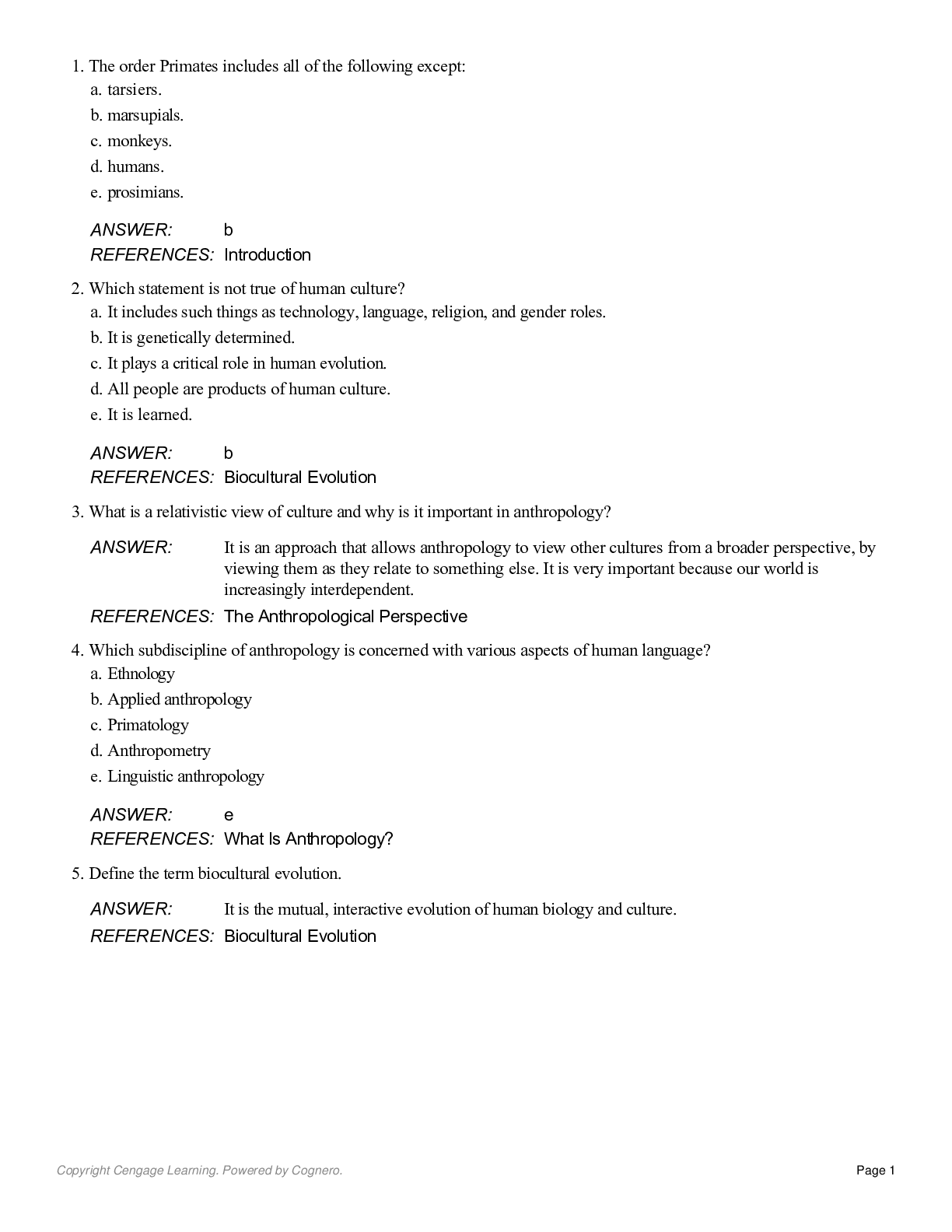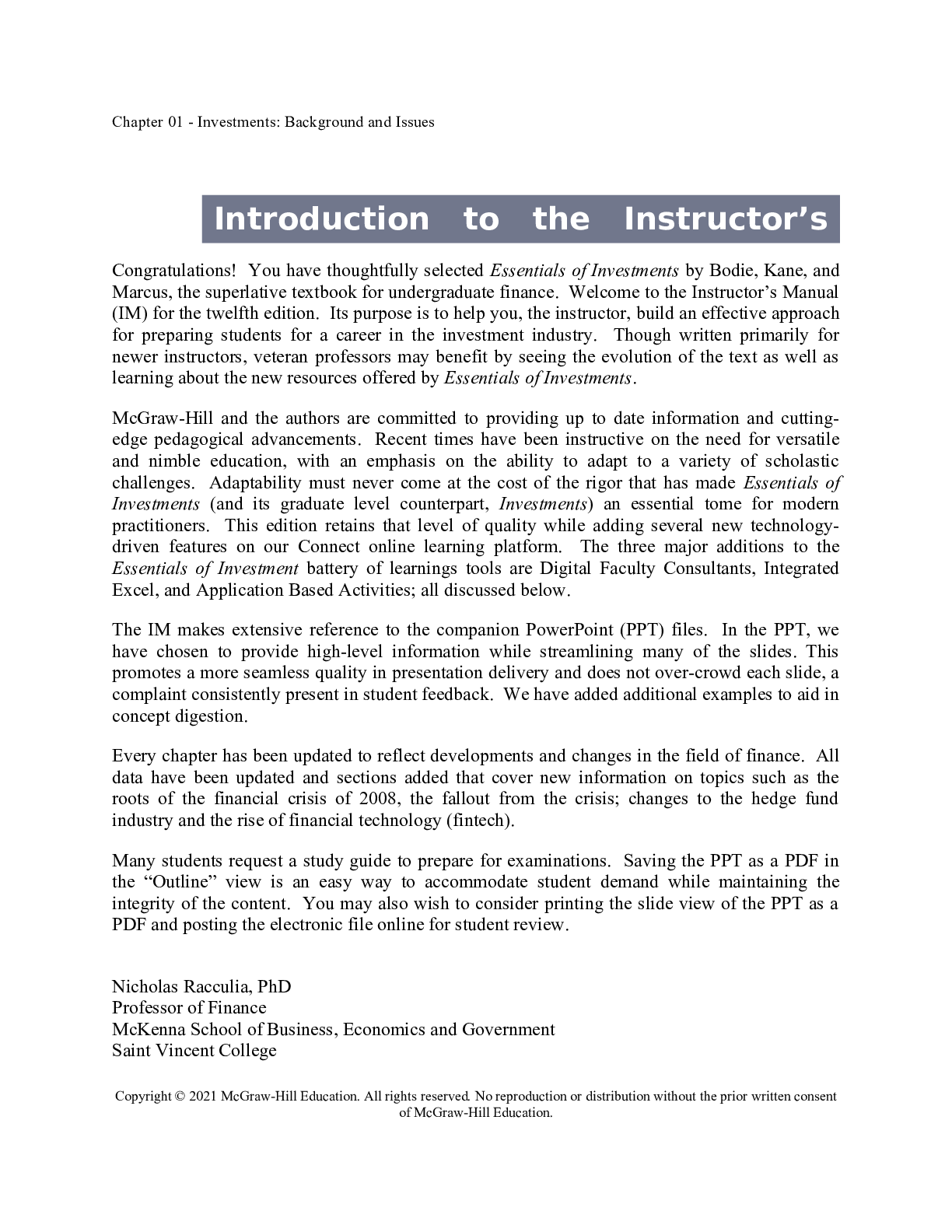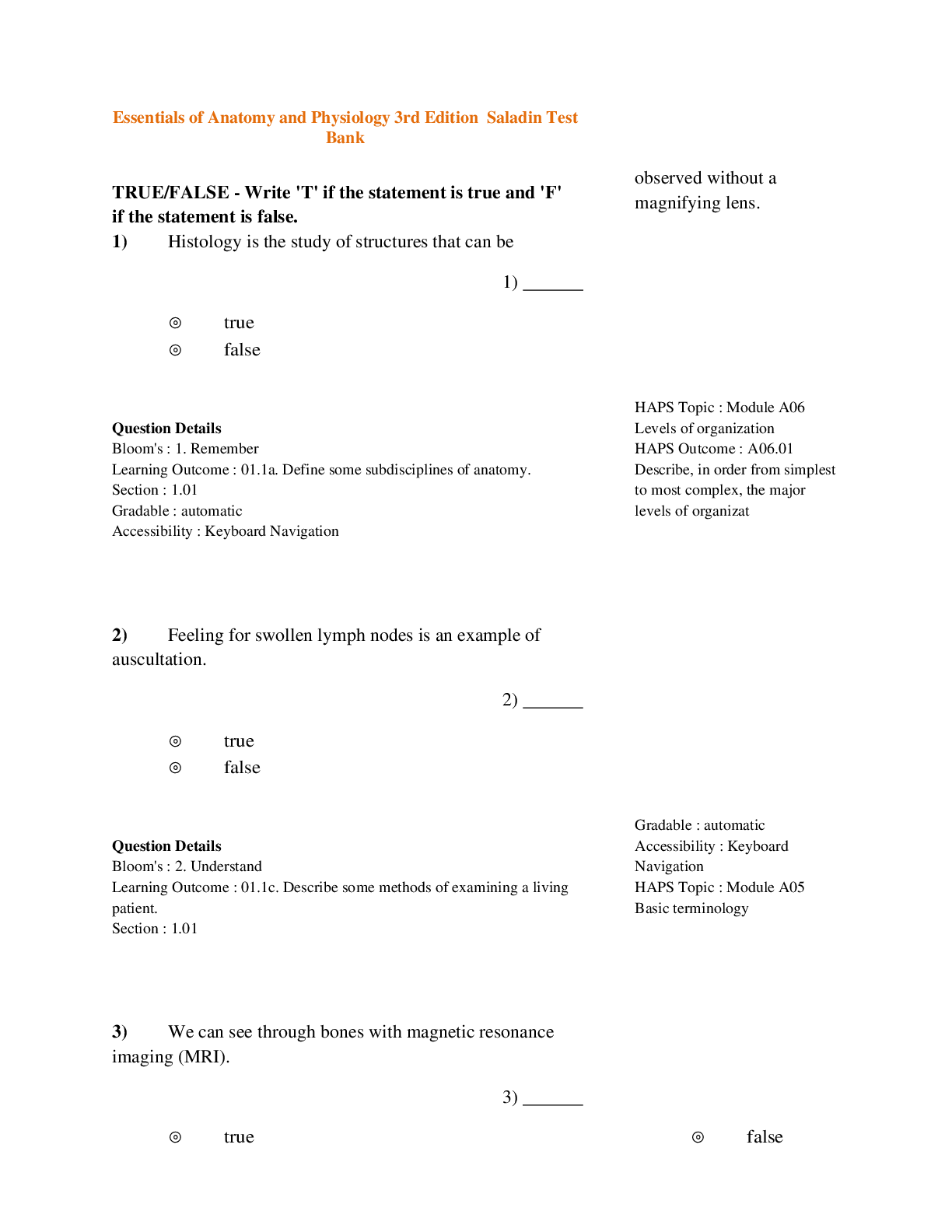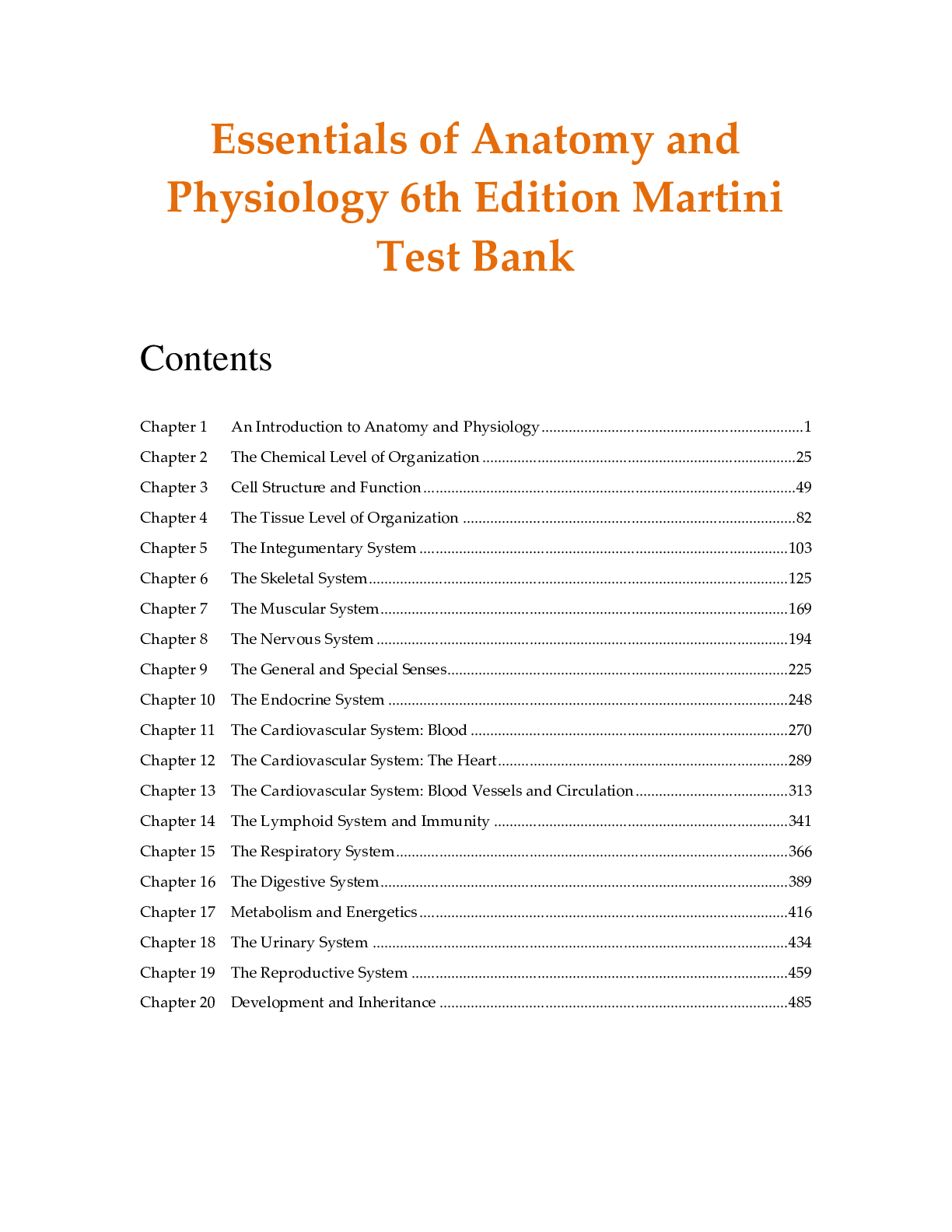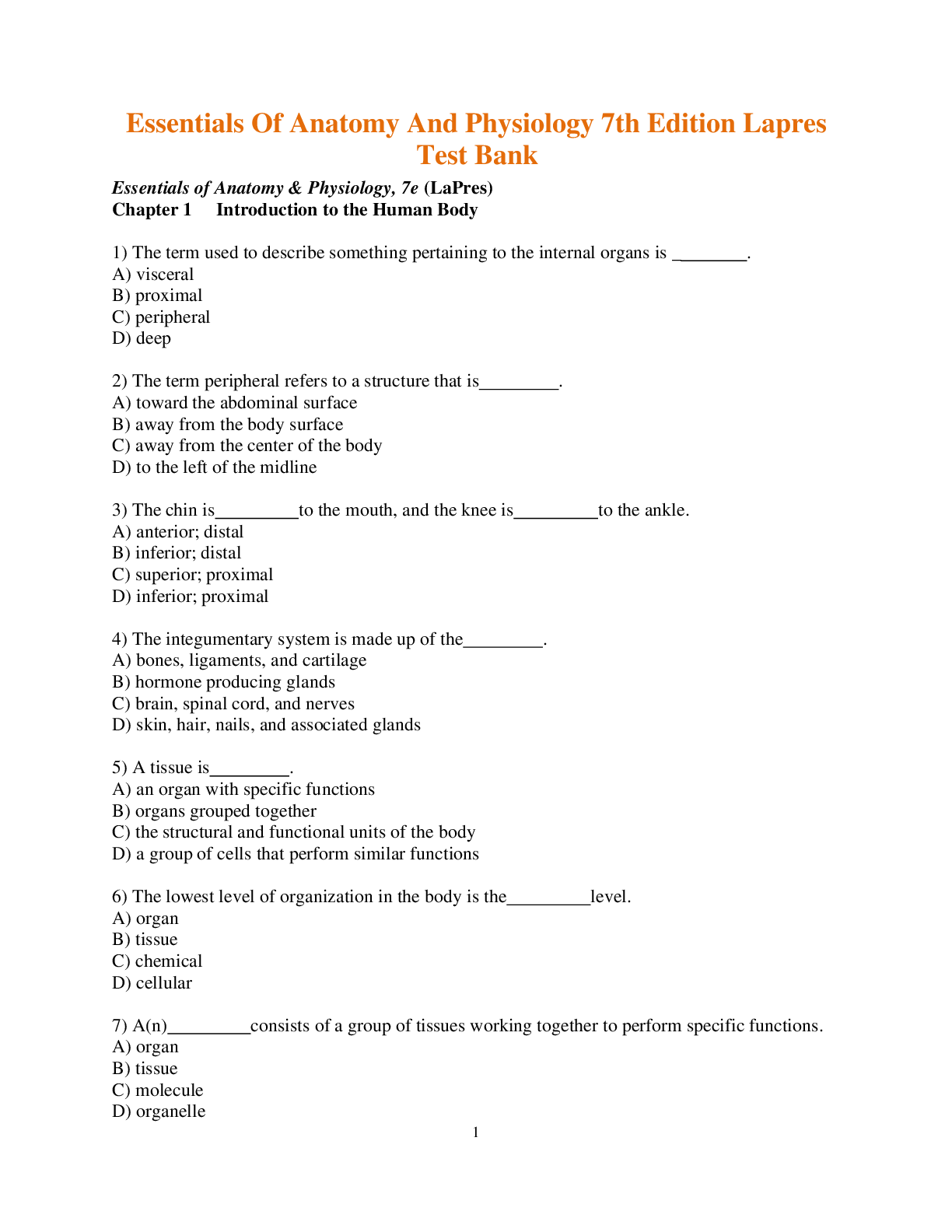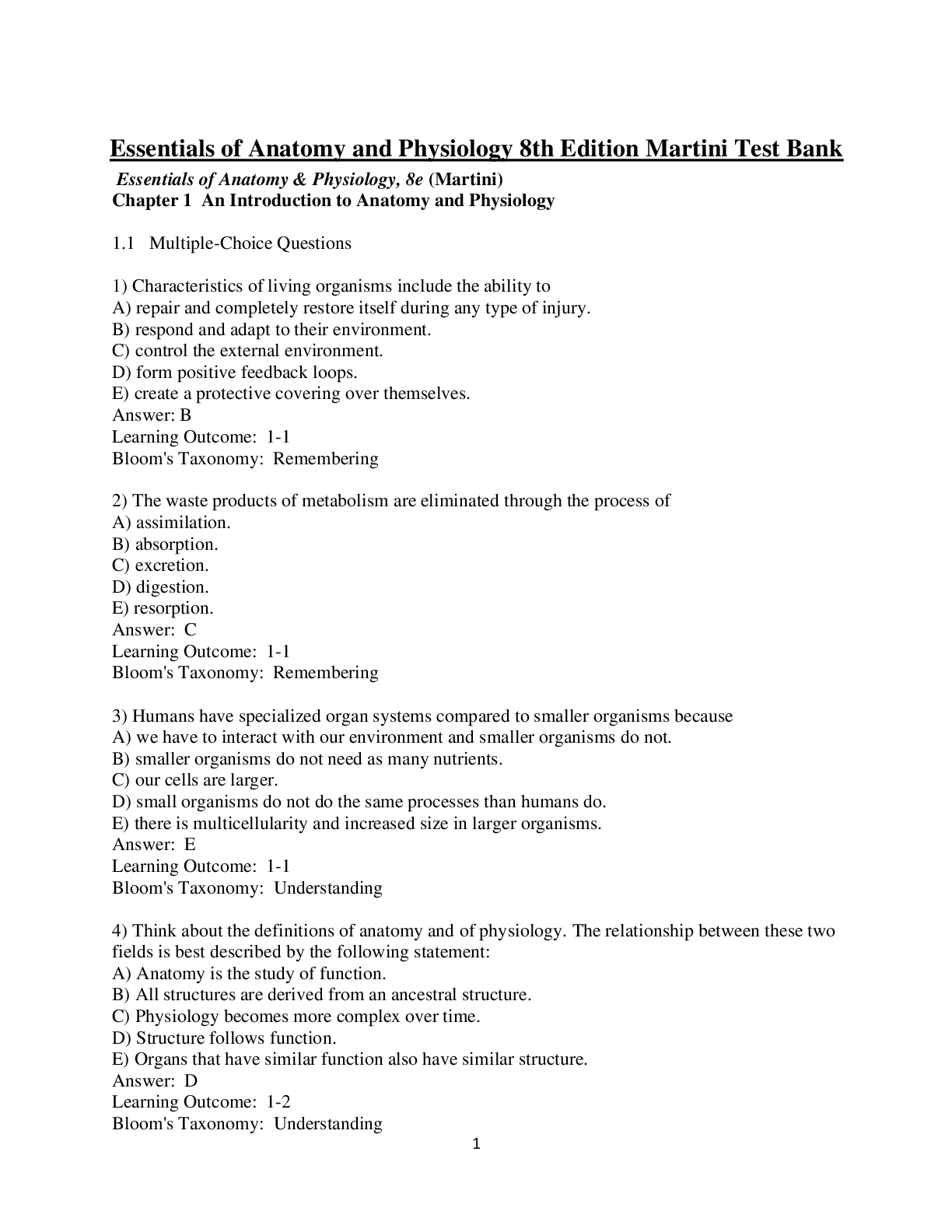Health Care > TEST BANK > TEST BANK for ESSENTIALS OF PATHOPHYSIOLOGY 4TH EDITION PORTH (All)
TEST BANK for ESSENTIALS OF PATHOPHYSIOLOGY 4TH EDITION PORTH
Document Content and Description Below
TEST BANK for ESSENTIALS OF PATHOPHYSIOLOGY Table of Contents Table of Contents 1 Chapter 01 - Cell Structure and Function Chapter 02 - Cellular Responses to Stress, Injury, and Aging Chapte... r 03 - Inflammation, the Inflammatory Response, and Fever Chapter 04 - Cell Proliferation, Tissue Regeneration, and Repair Chapter 05 - Genetic Control of Cell Function and Inheritance Chapter 06 - Genetic and Congenital Disorders Chapter 07 - Neoplasia Chapter 08 - Disorders of Fluid, Electrolyte, and Acid-Base Balance Chapter 09 - Stress and Adaptation Chapter 10 - Disorders of Nutritional Status Chapter 11 - Disorders of White Blood Cells and Lymphoid Tissues Chapter 12 - Disorders of Hemostasis Chapter 13 - Disorders of Red Blood Cells Chapter 14 - Mechanisms of Infectious Disease Chapter 15 - Innate and Adaptive Immunity Chapter 16 - Disorders of the Immune Response Chapter 17 - Control of Cardiovascular Function Chapter 18 - Disorders of Blood Flow and Blood Pressure Chapter 19 - Disorders of Cardiac Function Chapter 20 - Heart Failure and Circulatory Shock Chapter 21 - Control of Respiratory Function Chapter 22 - Respiratory Tract Infections, Neoplasms, and Childhood Disorders Chapter 23 - Disorders of Ventilation and Gas Exchange Chapter 24 - Structure and Function of the Kidney Chapter 25 - Disorders of Renal Function Chapter 26 - Acute Kidney Injury and Chronic Kidney Disease Chapter 27 - Disorders of the Bladder and Lower Urinary Tract Chapter 28 - Structure and Function of the Gastrointestinal System Chapter 29 - Disorders of Gastrointestinal Function Chapter 30 - Disorders of Hepatobiliary and Exocrine Pancreatic Function Chapter 31 - Mechanisms of Endocrine Control Chapter 32 - Disorders of Endocrine Control of Growth and Metabolism Chapter 33 - Diabetes Mellitus and the Metabolic Syndrome Chapter 34 - Organization and Control of Neural Function Chapter 35 - Somatosensory Function, Pain, and Headache Chapter 36 - Disorders of Neuromuscular Function Chapter 37 - Disorders of Brain Function Chapter 38 - Disorders of Special Sensory Function Chapter 39 - Disorders of the Male Genitourinary System Chapter 40 - Disorders of the Female Genitourinary System Chapter 41 - Sexually Transmitted Infections Chapter 42 - Structure and Function of the Skeletal System Chapter 43 - Disorders of the Skeletal System Chapter 44 - Disorders of the Skeletal System Chapter 45 - Structure and Function of the Integumentum Chapter 46 - Disorders of Skin Integrity and Function 2 8 15 22 26 32 38 45 52 59 65 72 79 86 93 100 107 113 120 127 134 140 147 153 160 166 173 180 187 193 199 206 212 219 225 231 238 245 251 257 263 269 275 282 288 294 Chapter 01 - Cell Structure and Function 1. The nucleus , which is essential for function and survival of the cell. A) is the site of protein synthesis B) contains the genetic code C) transforms cellular energy D) initiates aerobic metabolism 2. Although energy is not made in mitochondria, they are known as the power plants of the cell because they: A) contain RNA for protein synthesis. B) utilize glycolysis for oxidative energy. C) extract energy from organic compounds. D) store calcium bonds for muscle contractions. 3. Although the basic structure of the cell plasma membrane is formed by a lipid bilayer, most of the specific membrane functions are carried out by: A) bound and transmembrane proteins. B) complex, long carbohydrate chains. C) surface antigens and hormone receptors. D) a gating system of selective ion channels. 4. To effectively relay signals, cell-to-cell communication utilizes chemical messenger systems that: A) displace surface receptor proteins. B) accumulate within cell gap junctions. C) bind to contractile microfilaments. D) release secretions into extracellular fluid. 5. Aerobic metabolism, also known as oxidative metabolism, provides energy by: A) removing the phosphate bonds from ATP. B) combining hydrogen and oxygen to form water. C) activating pyruvate stored in the cytoplasm. D) breaking down glucose to form lactic acid. 6. Exocytosis, the reverse of endocytosis, is important in into the extracellular fluid. A) Engulfing and ingesting fluid and proteins for transport B) Killing, degrading, and dissolving harmful microorganisms C) Removing cellular debris and releasing synthesized substances D) Destruction of particles by lysosomal enzymes for secretion 7. The process responsible for generating and conducting membrane potentials is: A) diffusion of current-carrying ions. B) millivoltage of electrical potential. C) polarization of charged particles. D) ion channel neurotransmission. 8. Epithelial tissues are classified according to the shape of the cells and the number of layers. Which of the following is a correctly matched description and type of epithelial tissue? A) Simple epithelium: cells in contact with intercellular matrix; some do not extend to surface B) Stratified epithelium: single layer of cells; all cells rest on basement membrane C) Glandular epithelium: arise from surface epithelia and underlying connective tissue D) Pseudostratified epithelium: multiple layers of cells; deepest layer rests on basement membrane 9. Connective tissue contains fibroblasts that are responsible for: A) providing a fibrous framework for capillaries. B) synthesis of collagen, elastin, and reticular fibers. C) forming tendons and the fascia that covers muscles. D) filling spaces between tissues to keep organs in place. 10. Although all muscle tissue cells have some similarities, smooth muscle (also known as involuntary muscle) differs by: A) having dense bodies attached to actin filaments. B) containing sarcomeres between Z lines and M bands. C) having rapid contractions and abundant cross-striations. D) contracting in response to increased intracellular calcium. 11. Which of the following aspects of the function of the nucleus is performed by ribosomal RNA (rRNA)? A) Copying and carrying DNA instructions for protein synthesis B) Carrying amino acids to the site of protein synthesis C) Providing the site where protein synthesis occurs D) Regulating and controlling protein synthesis 12. Breakdown and removal of foreign substances and worn-out cell parts are performed by which of the following organelles? A) Lysosomes B) Golgi apparatus C) Ribosomes D) Endoplasmic reticulum (ER) 13. Impairment in the function of peroxisomes would result in: A) inadequate sites for protein synthesis. B) an inability to transport cellular products across the cell membrane. C) insufficient energy production within a cell. D) accumulation of free radicals in the cytoplasm. 14. After several months of trying to conceive, a couple is undergoing fertility testing. Semen analysis indicates that the man’s sperm have decreased motility, a finding that is thought to underlie the couple’s inability to become pregnant. Which of the following cellular components may be defective within the man’s sperm? A) Ribosomes B) Microtubules C) Mitochondria D) Microfilaments 15. Which of the following statements is true of glycolysis? A) Glycolysis requires oxygen. B) Glycolysis occurs in cells without mitochondria. C) Glycolysis provides the majority of the body’s energy needs. D) Glycolysis produces energy, water, and carbon dioxide. 16. Which of the following membrane transport mechanisms requires the greatest amount of energy? A) Facilitated diffusion B) Passive transport C) Vesicular transport D) Simple diffusion 17. A male patient with a diagnosis of type 1 diabetes mellitus is experiencing hyperglycemia because he lacks sufficient insulin to increase the availability of glucose transporters in his cell membranes. Consequently, his cells lack intracellular glucose and it accumulates in his blood. Which of the following processes would best allow glucose to cross his cell membranes? A) Facilitated diffusion B) Simple diffusion C) Secondary active transport D) Endocytosis 18. Which of the following statements is true of skeletal muscle cells? A) Skeletal muscle cells each have an apical, lateral, and basal surface. B) They are closely apposed and are joined by cell-to-cell adhesion molecules. C) Their basal surface is attached to a basement membrane. D) Skeletal muscle is multinucleated, lacking true cell boundaries. 19. Which of the following body tissues exhibits the highest rate of turnover and renewal? A) The squamous epithelial cells of the skin B) The connective tissue supporting blood vessels C) The skeletal muscle that facilitates movement D) The nervous tissue that constitutes the central nervous system 20. A patient with a pathophysiologic condition that affects the desmosomes is most likely to exhibit: A) impaired contraction of skeletal and smooth muscle. B) weakness of the collagen and elastin fibers in the extracellular space. C) impaired communication between neurons and effector organs. D) separation at the junctions between epithelial cells. Chapter 02 - Cellular Responses to Stress, Injury, and Aging 1. Ischemia and other toxic injuries increase the accumulation of intracellular calcium as a result of: A) release of stored calcium from the mitochondria. B) improved intracellular volume regulation. C) decreased influx across the cell membrane. D) attraction of calcium to fatty infiltrates. 2. The patient is found to have liver disease, resulting in the removal of a lobe of his liver. Adaptation to the reduced size of the liver leads to of the remaining liver cells. A) metaplasia B) organ atrophy C) compensatory hyperplasia D) physiologic hypertrophy 3. A person eating peanuts starts choking and collapses. His airway obstruction is partially cleared, but he remains hypoxic until he reaches the hospital. The prolonged cell hypoxia caused a cerebral infarction and resulting in the brain. A) caspase activation B) coagulation necrosis C) rapid phagocytosis D) protein p53 deficiency 4. Bacteria and viruses cause cell damage by , which is unique from the intracellular damage caused by other injurious agents. A) disrupting the sodium/potassium ATPase pump B) interrupting oxidative metabolism processes C) replicating and producing continued injury D) decreasing protein synthesis and function 5. The patient has a prolonged interruption in arterial blood flow to his left kidney, causing hypoxic cell injury and the release of free radicals. Free radicals damage cells by: A) destroying phospholipids in the cell membrane. B) altering the immune response of the cell. C) disrupting calcium storage in the cell. D) inactivation of enzymes and mitochondria. 6. Injured cells have impaired flow of substances through the cell membrane as a result of: A) increased fat load. B) altered permeability. C) altered glucose utilization. D) increased surface receptors. 7. Reversible adaptive intracellular responses are initiated by: A) stimulus overload. B) genetic mutations. C) chemical messengers. D) mitochondrial DNA. 8. Injured cells become very swollen as a result of: A) increased cell protein synthesis. B) altered cell volume regulation. C) passive entry of potassium into the cell. D) bleb formation in the plasma membrane. 9. A diabetic patient has impaired sensation, circulation, and oxygenation of his feet. He steps on a piece of glass, the wound does not heal, and the area tissue becomes necrotic. The necrotic cell death is characterized by: A) rapid apoptosis. B) cellular rupture. C) shrinkage and collapse. D) chronic inflammation. 10. A 99-year-old woman has experienced the decline of cell function associated with age. A group of theories of cellular aging focus on programmed: A) changes with genetic influences. B) elimination of cell receptor sites. C) insufficient telomerase enzyme. D) DNA mutation or faulty repair. 11. An 89-year-old female patient has experienced significant decreases in her mobility and stamina during a 3-week hospital stay for the treatment of a femoral head fracture. Which of the following phenomena most likely accounts for the patient’s decrease in muscle function that underlies her reduced mobility? A) Impaired muscle cell metabolism resulting from metaplasia B) Dysplasia as a consequence of inflammation during bone remodeling C) Disuse atrophy of muscle cells during a prolonged period of immobility D) Ischemic atrophy resulting from vascular changes while on bedrest 12. A 20-year-old college student has presented to her campus medical clinic for a scheduled Papanicolaou (Pap) smear. The clinician who will interpret the smear will examine cell samples for evidence of: A) changes in cell shape, size, and organization. B) the presence of unexpected cell types. C) ischemic changes in cell samples. D) abnormally high numbers of cells in a specified field. 13. Which of the following pathophysiologic processes is most likely to result in metastatic calcification? A) Benign prostatic hyperplasia B) Liver cirrhosis C) Impaired glycogen metabolism D) Hyperparathyroidism 14. Despite the low levels of radiation used in contemporary radiologic imaging, a radiology technician is aware of the need to minimize her exposure to ionizing radiation. What is the primary rationale for the technician’s precautions? A) Radiation stimulates pathologic cell hypertrophy and hyperplasia. B) Radiation results in the accumulation of endogenous waste products in the cytoplasm. C) Radiation interferes with DNA synthesis and mitosis. D) Radiation decreases the action potential of rapidly dividing cells. 15. The parents of a 4-year-old girl have sought care because their daughter has admitted to chewing and swallowing imported toy figurines that have been determined to be made of lead. Which of the following blood tests should the care team prioritize? A) White blood cell levels with differential B) Red blood cell levels and morphology C) Urea and creatinine levels D) Liver function panel 16. A 70-year-old male patient has been admitted to a hospital for the treatment of a recent hemorrhagic stroke that has left him with numerous motor and sensory deficits. These deficits are most likely the result of which of the following mechanisms of cell injury? A) Free radical injury B) Hypoxia and ATP depletion C) Interference with DNA synthesis D) Impaired calcium homeostasis 17. Which of the following processes associated with cellular injury is most likely to be reversible? A) Cell damage resulting from accumulation of fat in the cytoplasm B) Cellular changes as a result of ionizing radiation C) Cell damage from accumulation of free radicals D) Apoptosis 18. The extrinsic pathway of apoptosis can be initiated by: A) damage to cellular DNA. B) decreased ATP levels. C) activation of the p53 protein. D) activation of death receptors on the cell surface. 19. A patient with severe peripheral vascular disease has developed signs of dry gangrene on the great toe of one foot. Which of the following pathophysiologic processes most likely contributed to this diagnosis? A) Inappropriate activation of apoptosis B) Bacterial invasion C) Impaired arterial blood supply D) Metaplastic cellular changes 20. Which of the following facts underlies the concept of replicative senescence? A) Genes controlling longevity are present or absent in varying quantities among different individuals. B) Telomeres become progressively shorter in successive generations of a cell. C) The damaging influence of free radicals increases exponentially in later generations of a cell. D) Aging produces mutations in DNA and deficits in DNA repair. Chapter 03 - Inflammation, the Inflammatory Response, and Fever 1. The characteristic, localized cardinal signs of acute inflammation include: A) fever. B) fatigue. C) redness. D) granuloma. 2. The vascular, hemodynamic stage of acute inflammation is initiated by momentary vasoconstriction followed by vasodilation that causes localized: A) bleeding. B) congestion. C) pale skin. D) coolness. 3. The cellular stage of acute inflammation is marked by the movement of leukocytes into the area. Which of the following cells arrives early in great numbers? A) Basophils B) Lymphocytes C) Neutrophils D) Platelets 4. The phagocytosis process involves three distinct steps. What is the initial step in the process? A) Engulfment B) Intracellular killing C) Antigen margination D) Recognition and adherence 5. Which of the following mediators of inflammation causes increased capillary permeability and pain? A) Serotonin B) Histamine C) Bradykinin D) Nitric oxide 6. Inflammatory exudates are a combination of several types. Which of the following exudates is composed of enmeshed necrotic cells? A) Serous B) Fibrinous C) Suppurative D) Membranous 7. The acute-phase systemic response usually begins within hours of the onset of inflammation and includes: A) fever and lethargy. B) decreased C-reactive protein. C) positive nitrogen balance. D) low erythrocyte sedimentation rate. 8. In contrast to acute inflammation, chronic inflammation is characterized by which of the following phenomena? A) Profuse fibrinous exudation B) A shift to the left of granulocytes C) Metabolic and respiratory alkalosis D) Lymphocytosis and activated macrophages 9. Exogenous pyrogens (interleukin-1) and the presence of bacteria in the blood lead to the release of endogenous pyrogens that: A) stabilize thermal control in the brain. B) produce leukocytosis and anorexia. C) block viral replication in cells. D) inhibit prostaglandin release. 10. An older adult patient has just sheared the skin on her elbow while attempted to boost herself up in bed, an event that has precipitated acute inflammation in the region surrounding the wound. Which of the following events will occur during the vascular stage of the patient’s inflammation? A) Outpouring of exudate into interstitial spaces B) Chemotaxis C) Accumulation of leukocytes along the epithelium D) Phagocytosis of cellular debris 11. Which of the following individuals most likely has the highest risk of experiencing chronic inflammation? A) A patient who has recently been diagnosed with type 2 diabetes B) A patient who is a carrier of an antibiotic-resistant organism C) A patient who is taking oral antibiotics for an upper respiratory infection D) A patient who is morbidly obese and who has a sedentary lifestyle 12. Which of the following core body temperatures is within normal range? A) 35.9°C (96.6°F) B) 38.0°C (100.4°F) C) 35.5°C (95.9°F) D) 37.3°C (99.1°F) 13. A postsurgical patient who is recovering in the postanesthetic recovery unit states that she is freezing cold. Which of the following measures is likely to be initiated in the patient’s hypothalamus in an effort to reduce heat loss? A) Opening of arteriovenous (AV) shunts B) Reduced exhalation of warmed air C) Contraction of pilomotor muscles D) Decreased urine production 14. An elderly patient is dressed only in a hospital gown and complains of a draft in her room. Consequently, she has requested a warm blanket while she sits in her wheelchair. Which of the following mechanisms of heat loss is most likely the primary cause of her request? A) Evaporation and conduction B) Radiation and convection C) Conduction and convection D) Convection and evaporation 15. Which of the following pathophysiologic processes are capable of inducing the production of pyrogens? Select all that apply. A) Acute inflammation B) Obesity C) Myocardial infarction D) Malignancy E) Renal failure 16. Which of the following patients is most likely to be susceptible to developing a neurogenic fever? A) A patient who has stage II Alzheimer disease B) A patient who has sustained a head injury in a bicycle crash C) A patient who has become delirious after the administration of a benzodiazepine D) A patient who has begun taking a selective serotonin-reuptake inhibitor (SSRI) for the treatment of depression 17. Patients are commonly administered antipyretics when their oral temperature exceeds 37.5°C (99.5°F). Which of the following statements related to the rationale for this action is most accurate? A) Temperatures in excess of 37.5°C (99.5°F) can result in seizure activity. B) Lower temperatures inhibit the protein synthesis of bacteria. C) There is little empirical evidence for this treatment modality. D) Most common antipyretics have been shown to have little effect on core temperature. 18. A patient has sought care because of recent malaise and high fever. Upon assessment, the patient states that his current fever began two days earlier, although he states that for the last 2 weeks he is in a cycle of high fever for a couple of days followed by a day or two of normal temperature. Which of the following fever patterns is this patient experiencing? A) Recurrent fever B) Remittent fever C) Sustained fever D) Intermittent fever 19. A febrile, 3-week-old infant has been brought to the emergency department by his parents and is currently undergoing a diagnostic workup to determine the cause of his fever. Which of the following statements best conveys the rationale for this careful examination? A) The immature hypothalamus is unable to perform normal thermoregulation. B) Infants are susceptible to serious infections because of their decreased immune function. C) Commonly used antipyretics often have no effect on the core temperature of infants. D) Fever in neonates is often evidence of a congenital disorder rather than an infection. 20. An 84-year-old patient’s blood cultures have come back positive, despite the fact that his oral temperature has remained within normal range. Which of the following phenomena underlies the alterations in fever response that occur in the elderly? A) Disturbance in the functioning of the thermoregulatory center B) Increased heat loss by evaporation C) The presence of comorbidities that are associated with lowered core temperature D) Persistent closure of arteriovenous shunts Chapter 04 - Cell Proliferation, Tissue Regeneration, and Repair 1. Epithelialization, the first component of the proliferative phase of wound healing, is delayed in open wounds until after has formed. A) granulation tissue B) fibrinous meshwork C) capillary circulation D) collagenous layers 2. A mutation has occurred during mitosis of an individual’s bone marrow cell. This event may be the result of the failure of which of the following? A) Progenitor cells B) Fibroblasts C) Stem cells D) Cyclins 3. A patient has experienced a myocardial infarction with accompanying necrosis of cardiac muscle, a permanent tissue. What are the ramifications of the fact that cardiac muscle is a permanent tissue? A) The cardiac muscle cells will remain perpetually in the G1 stage of mitosis. B) Regeneration of the patient’s cardiac muscle will be exceptionally slow. C) The necrotic cells will be replaced with muscle cells that have limited metabolism. D) The cells will not proliferate and will be replaced with scar tissue. 4. A couple have chosen to pay for the harvesting and storage of umbilical cord blood after the delivery of their child to secure a future source of embryonic stem cells. What is the most likely rationale for the couple’s decision? A) The stem cells may be able to produce a wide range of body cells. B) The embryonic stem cells allow stable and permanent tissues to enter mitosis. C) The stem cells can change the proliferative capacity of other cells. D) The embryonic stem cells remove cyclin-dependent kinase inhibitors from the body. 5. The basement membrane surrounding a patient’s foot wound remains intact, a fact that bodes well for the wound-healing process. Which of the following components constitute this form of the extracellular matrix? Select all that apply. A) Prostaglandins B) Fibrous structural proteins C) Lymphocytes D) Water-hydrated gels E) Glycoproteins 6. A nursing student is cleaning and changing the dressing on a patient’s sacral ulcer. The student has vigorously cleansed the wound bed to remove all traces of the beefy, red tissue that existed in the wound bed. The student has most likely removed: A) Necrotic tissue B) Granulation tissue C) Stem cells D) The extracellular matrix 7. A 12-year-old boy’s severe wound that he received from a dog bite has begun to heal and currently shows no signs of infection. Which of the following processes occurred first during this process of repair by connective tissue deposition? A) Reorganization of fibrous tissue B) Angiogenesis C) Emigration of fibroblasts to the wound site D) Deposition of the extracellular matrix 8. Which of the following wounds is most likely to heal by secondary intention? A) A finger laceration that a cook received while cutting up onions B) A boy’s road rash that he got by falling off his bicycle C) A needlestick injury that a nurse received when injecting a patient’s medication D) The incision from a teenager’s open appendectomy 9. A patient underwent an open cholecystectomy 4 days ago and her incision is now in the proliferative phase of healing. What is the dominant cellular process that characterizes this phase of the patient’s healing? A) Hemostasis and vasoconstriction B) Keloid formation C) Collagen secretion by fibroblasts D) Phagocytosis by neutrophils 10. Which of the following surgical patients is most likely to experience enhanced wound healing as a result of his or her diet? A) A patient who eats a high-calorie diet and large amounts of red meat B) A patient who is a vegetarian and who eats organic foods whenever possible C) A patient who practices carefully calorie control and who avoids animal fats D) A patient who is receiving total parenteral nutrition due to recurrent nausea 11. Which of the following patients is most likely to experience impaired wound healing? A) A patient with a diagnosis of type 1 diabetes and a history of poor blood sugar control B) A child whose severe cleft lip and palate have required a series of surgeries over several months C) A patient who takes nebulized bronchodilators several times daily to treat chronic obstructive pulmonary disease D) A patient with persistent hypertension who takes a b-adrenergic blocker and a potassium-wasting diuretic daily Chapter 05 - Genetic Control of Cell Function and Inheritance 1. Triplet codes of three bases are the genetic codes used in transmitting genetic information necessary for: A) chromatin formation. B) protein synthesis. C) enzyme activation. D) nucleotide bonding. 2. Unlike messenger RNA (mRNA) and transfer RNA (tRNA), ribosomal RNA (rRNA): A) is produced in the nucleolus. B) delivers activated amino acids. C) is formed by transcription. D) coordinates RNA translation. 3. Splicing of mRNA during processing permits a cell to: A) form different proteins. B) increase DNA content. C) stop copying DNA onto RNA. D) add nucleic acid end pieces. 4. When an infant is born with gene mutations in his/her cells, the errors may be a result of all of the following except of base pairs. A) deletion B) substitution C) differentiation D) rearrangement 5. Identifying the genetic sex of a child is based on finding intracellular Barr bodies that consist of: A) inactive chromatin material. B) male-specific chromosomes. C) homologous chromosomes. D) excess autosomal material. 6. Multifactorial inheritance is similar to polygenic inheritance because both involve: A) environmental effects on alleles. B) multiple alleles at different loci. C) predictable somatic allele effects. D) homozygous pairing of two alleles. 7. Crossing over of chromatid segments during meiosis division 1 results in: A) spontaneous gene mutations. B) initial DNA synthesis. C) bivalent X and Y genes. D) new gene combinations. 8. During the transcription process, RNA: A) polymerase attaches to DNA. B) exon sequences are reversed. C) delivers activated amino acids. D) reverses redundant base pairs. 9. The process of gene expression is increased by: A) mutation of normal suppressor genes. B) induction by an external influence. C) repression of internal penetrance. D) activation of growth control genes. 10. Gene therapy, insertion of genes into the genome of multicellular organisms, is accomplished by: A) restriction enzymes. B) transferring genes. C) DNA fragment separation. D) cross-over gene exchange. 11. Which of the following statements is true of genetic mutations? A) Errors in DNA duplication are normally irreparable. B) Mutations that occur in somatic cells are inheritable. C) Mutations may result from extrinsic factors or from spontaneous error. D) Errors in DNA replication are most often fatal. 12. Individual differences in appearance, behavior, and disease susceptibility are a result of: A) karyotyping. B) mutations. C) DNA repair. D) a haplotype. 13. Which of the following statements is true of messenger RNA (mRNA)? A) mRNA is produced in the nucleolus. B) mRNA provides the template for protein synthesis. C) Each mRNA molecule has two recognition sites. D) mRNA delivers the activated form of an amino acid to the protein being synthesized. 14. Prenatal genetic testing that counts the number of Barr bodies in a chromosome is able to determine: A) the genetic sex of a child. B) susceptibility to hemophilia B. C) the presence of fragile X syndrome. D) fetal viability. 15. The gene responsible for a particular congenital cardiac anomaly is said to have complete penetrance. What are the clinical implications of this fact? A) The anomaly is a result of polygenetic inheritance. B) The heart defect does not result from any other gene. C) Multiple alleles contribute to the defect. D) All the individuals who possess the gene will exhibit the anomaly. 16. A dominant genetic trait: A) is expressed only in a heterozygous pairing. B) is expressed in either a homozygous or heterozygous pairing. C) is expressed only in a homozygous pairing. D) is expressed in some carriers. 17. Which of the following methods of genetic mapping focuses on the measurement of enzyme activity? A) Hybridization studies B) Haplotype mapping C) Linkage studies D) Gene dosage studies 18. Which of the following facts underlies the application of RNA interference in the treatment of disease? A) Restriction enzymes are able to cleave genetic molecules at predictable sites. B) It is possible to produce proteins that have therapeutic properties. C) Faulty gene activity that produces unwanted proteins can sometimes be stopped. D) Individual differences are attributable to a very small percentage of the genes in the human body. 19. Although the majority of cellular DNA exists in the cell nucleus, part of the cell DNA is located in the: A) mitochondria. B) Golgi apparatus. C) smooth endoplasmic reticulum. D) microfilaments. 20. Which of the following is an application of recombinant DNA technology? A) Production of human insulin B) DNA fingerprinting C) Gene dosage studies D) Somatic cell hybridization [Show More]
Last updated: 8 months ago
Preview 1 out of 302 pages

Reviews( 0 )
Document information
Connected school, study & course
About the document
Uploaded On
Oct 08, 2021
Number of pages
302
Written in
Additional information
This document has been written for:
Uploaded
Oct 08, 2021
Downloads
0
Views
90


